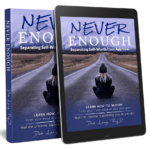This is the fourth in a series of posts on Rethinking Anxiety—a fresh perspective on anxiety.

If you have been following along with this series, you might be expecting this post to be about Bruised Toes and Anxiety. I decided to hold off on that post and continue sharing the benefits of befriending your body as it supports you during stressful events.
Most of us tend to think of the body’s response to stress as having a single focus—survival or the fight, flight, or freeze response. This is the response that is most talked about, and this is the response most often experienced by those who struggle with anxiety because of their reaction to their symptoms.
Being in the fight-or-flight state, or what I refer to as the “desperate state,” is not comfortable. If you are running or fighting for your life, you won’t be noticing the changes in your body—you will be too busy trying to stay alive.
When your life is not in danger and you are sitting in a meeting, this is not the state you want to be in. It is uncomfortable and with your thinking brain offline, not the least bit conducive to performing.
Why do we have this outdated system?

Over the years, clients have expressed frustration at possessing a stress response that is unhelpful for the stressors we face today. My typical response has been to share that I feel grateful for this system that is there to protect me if my life should be in danger.
I still believe that, and it’s one of those topics about which I wish I could somehow rewind the tape, go back, and provide a better explanation using information I’ve learned since then.
It wasn’t until after The Upside of Stress by Kelly McGonigal, Ph.D. was published in 2015 that I learned that our stress response has evolved, and that we do, in fact, have more than one type of response to stress—responses designed to help us perform, connect, and learn from our experiences.
The challenge response—the stress response designed to help us perform
The challenge response is just as the name suggests. It is a set of changes in the body that help us perform under pressure or in challenging situations. Similar to the fight-or-flight response, heart rate rises, adrenaline spikes, and the brain and muscles get more fuel.
Because of these similarities, the gearing up in the challenge response is often misinterpreted as a sign of anxiety and generates fear. The fear signals the body of danger and initiates the fight-or-flight response—the body’s response to threat.
When this happens, we miss out on the advantages of the challenge response.

The challenge response is often described as being “in the flow.” Athletes, performers, and surgeons experience this type of stress response while performing. According to Dr. McGonigal, we assume they are calm, when in fact they have strong challenge responses.
She writes,
The stress response gives them access to their mental and physical resources, and the result is increased confidence, enhanced concentration, and peak performance.
The ratio of hormones released in this type of stress response also promotes quick recovery and the ability to learn from the experience.
Using the power of the challenge response
It must have been around the time that I learned about this response that I happened to catch an episode of The Voice. In this episode one of the contestants shares with her coach, Christina Aguilera, her worries about anxiety.
Christina said something along the lines of, “I’m anxious too. I use my anxiety. Learn how to use it.”
I remember thinking that she must use the challenge response to her benefit in performing.
Research supports that we can learn to recognize and use the challenge response to our advantage and make a difference in our level of performance and experience of anxiety.
And I have witnessed this possibility in my work with clients.
“I wasn’t calm”
In a previous post, I shared the experience of a client who had an “ah ha” moment when she realized that how she feels now when anxious is actually very similar to how she felt when she was a competitive swimmer and waiting on the starting blocks before a race.
She said, “I wasn’t calm, and I thought about it differently. I didn’t think of it as anxiety—it was the excitement of the race.”
This realization helped her to be less fearful of the changes in her body. She realized that her body geared up to help her and that it was the fear of those changes that had been sending her into incapacitating anxiety rather than a malfunctioning body.

She started reminding herself that her body was revving up to help her just like when she was on the starting blocks. Her experience with anxiety shifted.
She spent much less time in the threat response, and when she was there, she was less afraid, knowing that her body had somehow received the message that her life was in danger, and that she needed to give it time to calm down.
She took two critical steps that made a difference for her.
- She started appreciating when her body was revving up to help her perform.
- She accepted when her body had moved into the threat response.
Both of these kept her out of a horrible cycle of fear and worsening symptoms.
The tend-and-befriend response
The other stress response that we often miss when we move our body right into responding to a threat is the tend-and-befriend response. This part of the stress response motivates us to connect with others.
This striving for connection is caused by the release of oxytocin. Oxytocin helps build and strengthen social bonds. It also helps us to better notice and understand the thoughts and feelings of others, as well as to be more likely to help and trust those we care about.

I found the following to be particularly interesting. Oxytocin is also a “chemical of courage.” It does this by dampening the fear response and the desire to run or freeze so it makes us braver.
Unlike the fight-or-flight response, which is primarily about self-survival, the tend-and-befriend response motivates us to protect people we care about and gives us the courage to do so.
Oxytocin is also good for the heart, so a stress response that includes oxytocin can actually strengthen heart health.
Your stress response has a built-in mechanism for resilience—one that motivates you to care for others while also strengthening your heart.
Kelly McGonigal Ph.D.
Threat to Challenge
I hope that what I have shared helps you realize the resources that are available to you in your body’s responses to stress.
The key is being able to view the changes in your body as resources—not something to fear.
Rather than worrying that you are going to have a heart attack when your heart beats faster while facing a challenge like preparing to give a speech or meet new people, could you thank your body for working harder to give you more energy—for pumping more blood to your brain so you can think?
When your stomach starts to feel a bit off, what if you thought about how blood flow has moved to your brain and muscles because eating is not a priority when facing a challenge?
If you are not facing a challenge or a threat and your body has somehow received the message that you are, could you put your hand on your heart and thank your body for all the resources it has for you and reassure your body that you are safe?
What do you think?
Are you surprised to learn that the stress response can be so helpful? Can you think of times when you faced a challenge and had better concentration, a desire to connect or felt braver?
If so, take a moment to jot down how your body felt during that time. What was your heart rate like? How about your breathing?
Do you notice similarities between those times of focus when you were facing a challenge and the changes in your body that you label as anxiety, and which generate fear?

If you have not personally experienced the challenge or tend-and-befriend response because you move right into the threat response, could you use your imagination to feel what my client felt as a young competitive swimmer up on the starting blocks?
Or could you watch competitors before a race? What do you notice? Do they look calm? Or keyed up? My memory is that most look like they can’t stay still.
I’d love to hear your thoughts and reactions! You can do so by leaving me a comment below or by emailing me at [email protected]. If you know of anyone who might enjoy this post, please share.
* I would highly recommend any of Dr. McGonigal’s books. She has great information to share, and her writing is interesting and easy to understand.
With warmth and kindness,
Deb

If you find it hard to be yourself in the world, need to keep others happy to feel okay about yourself, or get derailed by disapproval, check out my book Never Enough—Separating Self-Worth from Approval
If you enjoyed this article, be sure to signup below so that you will receive notification when articles are published. Want to share your thoughts or have a topic you are interested in learning about, scroll down to leave a comment.

0 Comments